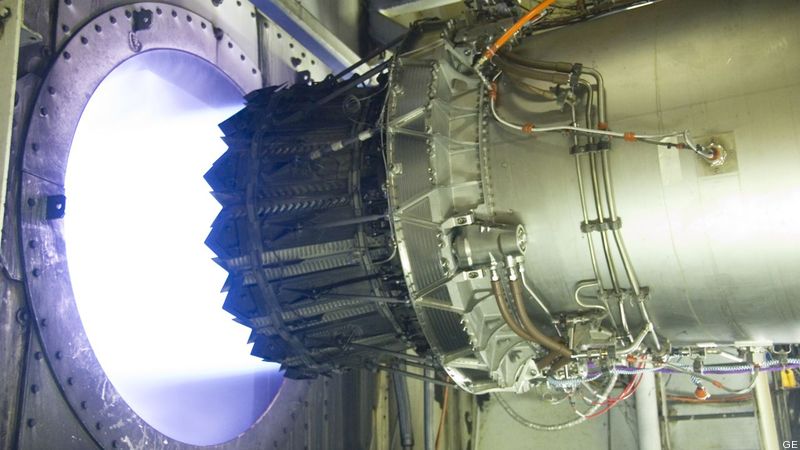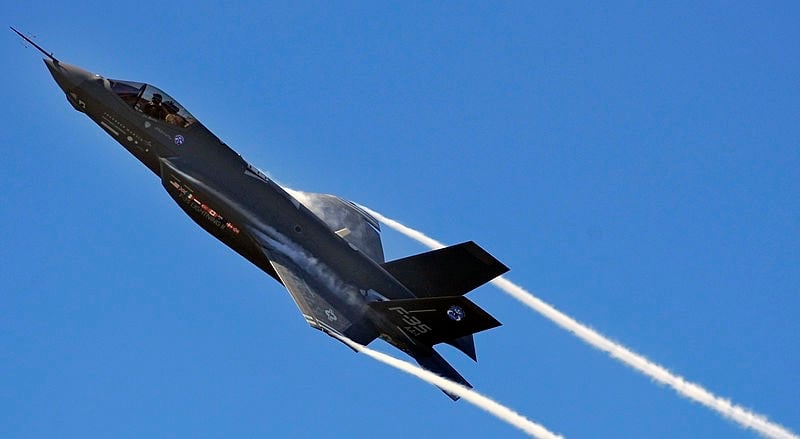If Trump Wants Lower F-35 Costs, He Should Compete F135 Engine
Posted on

GE’s F136 engine
Donald Trump has bemoaned the “over budget, behind schedule” F-35 program. He opened his first press conference as president-elect with a vow to do “big things” to bring down the aircraft’s cost and improve performance. That will take more than jaw-boning.
Applying heat to Lockheed will reduce costs to a degree, but it would take another 20 years to build a jet that genuinely competes with the cost and performance of the F-35. Luckily, there’s a better way.
Far greater performance, readiness, and real savings can be gleaned by opening its engine, the F135, to competition. When Lockheed Martin won the Joint Strike Fighter (JSF) fly-off to win what is arguably the largest defense contract in U.S. history, both prototypes were powered by Pratt & Whitney’s F135 engine. Pratt (naturally) won the contract to build the engine for the F-35, and the U.S. government funded more than $4.8 billion for that engine’s development on a drive to significantly improve three areas critical to fighter aircraft: performance, readiness, and cost.
Performance
Jet engines are measured by their ability to propel weight. If an engine can produce 40,000 pounds of thrust and is paired with an aircraft weighing 40,000 lbs, the jet’s one-to-one thrust-to-weight ratio allows it to aggressively maneuver to engage threats while maintaining airspeed. The ability for a fighter aircraft to either outturn and out-accelerate adversary aircraft and surface-to-air threats will remain critical to a jets survival for the foreseeable future. The overall design and weight of a fighter are naturally important factors in determining the performance requirements of fighter engines, and Pratt’s F135 has more than met the JSF’s original program specifications for thrust.
Unfortunately, the actual dimensions and weight of the three variants (Air Force F-35A, Marine STOVL F-35B, and the Navy’s carrier-based F-35C) have all grown over time and now exceed the original specs the F135 was designed to power. Every fighter gains weight throughout its development and operational life. The F-16 was designed as a lightweight fighter, but it put on almost 5,000 pounds during its first 10 years. The F-35 will be no different. The additional weight is almost always overcome by improvements in engine technology, spurred on through competition. The F-16’s original engine, the Pratt & Whitney F-100-200 (Pratt F-200) worked well for the first F-16s off the line. But as the jet grew around the waistline, its thrust-to-weight ratio deteriorated considerably. To improve performance and drive down unit costs for the F-16, the Air Force in 1984 wisely implemented the Alternative Fighter Engine (AFE) program. A competitive bidding process led to General Electric’s (GE) F-110, which delivered 5,000 pounds more thrust than Pratt’s motor.
The timing of the requests for the second F-16 engine gave Pratt their just due for that system, and they had every advantage for winning the inevitable follow-on competition. In the end, GE won the F-16’s AFE follow-on contract, but fighter pilots and taxpayers were the real winners of what became known as the Great Engine War. That competition gave the F-16 the thrust needed to improve its operational and readiness faculties, while saving the taxpayers money.

F-35A
To date, the F-35’s added weight has caused the four services to lower expectations for critical performance metrics for sustained turning performance (sustained g) and acceleration. The sustained turning requirement was reduced from 5.3 g’s to 4.6 for the F-35A; from 5.0 g’s to 4.5 for the F-35B, and from 5.1g’s to 5.0 for the F-35C. Losing half a “g” will hinder a pilot’s ability to maneuver the jet, but the loss in acceleration is a bigger concern. Being able to gain or recover airspeed is critical to fighter pilot survival, and the time it now takes for each variant of the F-35 to accelerate from Mach 0.8 to Mach 1.2 is far longer than outlined in the original specs. Compared to the original requirements, it now takes an F-35A model 8 additional seconds to get there; the B model 16 seconds longer; the F-35C takes a worrying 43 seconds longer. Both setbacks with sustained g and acceleration can be overcome with more thrust.
Readiness
Fighter aircraft engines produce more thrust under more stress than you might imagine. The F135 is the most powerful production-line fighter engine in the western hemisphere and, misinformed commentary to the contrary, has enjoyed a solid track record for reliability. Through the F-35’s more than 50,000 flight hours to date, there have been very few catastrophic failures. That said, given the extreme operating temperatures, pressures and complexities associated with this and any other fighter engine, failures are inevitable. In the 1990s, the United States flew eight different fighter aircraft, powered by as many different engines. A systemic failure of one motor may have hampered our efforts to win a major regional conflict, but with such a diversified portfolio of fighter aircraft/engines we would have been able to overcome the loss of a single aircraft type. The F-35 is slated to replace up to 90 percent of our combat fighter force, and every one of them will be powered by Pratt’s F135, which means the risk of a systemic engine failure will be much more crippling.
If that sounds far-fetched, think again. From December 15, 1998, to February 16, 2000 — a mere 14 months — Luke Air Force base lost five F-16s due to engine failure. The wing was grounded until it could determine a cause, which was found to be cracks in the Pratt and Whitney F-220 afterburner duct. The Air Force inspected the motors of every F-220 in its fleet and, while service-wide statistics are unknown, the wing at Luke found similar cracks in 63 of its engines. The consequences of a similar failure with the F-35’s single engine would not affect up to 90 percent of the U.S. fighter fleet; it would also impact seven of our key allies around the world.
Costs
The JSF team used the lessons learned from the F-16 to incorporate a competitive two-engine program into the F-35 acquisition strategy. The Defense Department gave the incumbent, Pratt & Whitney, a five-year head start on General Electric, but GE built its F136 engine to meet the looming requirement for more thrust. As the competition grew more intense, Pratt & Whitney ran an F135 up to 50,000 lbs. of thrust, exceeding the F-35 program specifications by some margin. As overall F-35 delays and cost overruns mounted, members of Congress moved aggressively to cut JSF developmental costs by terminating one of the two engines, pressed hard by then-Defense Secretary Bob Gates. Pratt’s F135 was already flying in the F-35 and it became the natural pick. Gates terminated GE’s F136 program in 2011, leaving Pratt & Whitney as the sole source of engines for the F-35. While many argue that even monopolies have to fight for excellence every day, there’s little real-world evidence to suggest that’s true.
World class track and field athletes rarely set personal bests running alone, and no athlete or business reaches its full potential without a competitor in the lane next to them. The history of the F-16 engine program reinforces that point, as does the nearly stagnant pricing history of the F135 engine/propulsion systems to date. Neither has dropped in line with program estimates, which brings us back to President-elect Trump’s recent communiques.
The Air Force currently has contracts with General Electric and Pratt & Whitney to develop a follow-on fighter engine technology, known as the Adaptive Engine Transition Program (ATEP). That motor will deliver more thrust, conserve more fuel and readily fit into the engine bay of either the F-35A or C. By adding accelerant to the Air Force’s initiative, the Trump administration can re-kindle the competition the F-35 needs to continue improving performance and readiness, while driving down costs. With a motor that can already produce 50,000 pounds of thrust, and with the contract to provide engines for all three F-35 variants in hand, Pratt is sitting in the catbird seat. There is no reason Pratt can’t come out on top in the next F-35 engine war, but until the Trump administration puts someone in the lane next to them, Pratt will continue to pace itself.
John Venable, a 25-year veteran of the Air Force, is a senior defense expert at The Heritage Foundation.
Subscribe to our newsletter
Promotions, new products and sales. Directly to your inbox.
